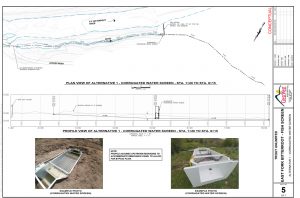
The Bitterroot National Forest is inviting the public to review and make comments on the East Fork Ditch Fish Screen Project. The project proposes to install a fish screen on the headgate of the East Fork Ditch. The East Fork Ditch is located on the north bank of the East Fork Bitterroot River at river mile 28.7, across from Bonanza lands subdivision 17 miles east of Sula. The legal location of the point of diversion is T2N, R17W, S20NW¼.
Installation of the fish screen would require the following activities: (1) excavating and building the foundation for the fish screen, (2) installing the screen, and (3) burying a “go back” pipe between the screen and the East Fork Bitterroot River. The “go back” pipe allows fish that swim up to the screen to be able to get back into the river. The footprint of the excavation is estimated at 20 feet wide by 20 feet long, centered on the existing headgate. Installation would occur between October 19th and December 1st.
The purpose of the project is to keep fish out of the ditch. In its currently unscreened condition, numerous Westslope cutthroat trout enter the ditch throughout the summer, and bull trout are also at risk of becoming trapped and perishing in the ditch when the water is shut off in October.
“Just the fact that it’s located on an important section of the river for Westslope cutthroat trout and bull trout makes it a high priority for a fish screen,” said Bitterroot National Forest fisheries biologist Michael Jakober. “You can add to this the fact that it is a bigger sized ditch,” he said.
According to Jakober, they have done some electro-shocking in that section of the river and in the first hundred meters of the ditch. Although no endangered bull trout were found in the ditch, bull trout were found in that section of the river.
Jakober said that the electro-shocking was limited to once per summer so that it doesn’t mean that no bull trout make it into the ditch.
“There is nothing stopping them,” said Jakober. He said the number of Westslope cutthroat trout found in the ditch has ranged from 15 to 40 in the first 100 meters of the ditch. Many are only 5 to 6 inches in length but some have been 10 to 12 inches. Some juvenile Mountain Whitefish were also found in the ditch.
The agency chose the lowest cost alternative as the “preferred alternative” in this case. The cost is estimated at $33,500. The other alternatives were estimated to cost $58,480 and $51,500 respectively.
The particular type of fish screen being proposed as the preferred alternative for installation, called a corrugated water screen, has not been used before in Ravalli County, according to Jakober. It is supposedly self-cleaning, although Jakober said the agency has found that no fish screen is really self-maintaining. They all take some sort of regular maintenance, some more than others.
But this uniquely designed passive screen, which uses water flow itself to clean the screen, promises to be much more efficient than the older style manual screens that could easily clog within an hour under certain conditions. The self-cleaning corrugated screens are also a whole lot cheaper than the more sophisticated self-cleaning screens with paddle wheels and mechanical wipers like the one up Skalkaho Creek.
Jakober said that the agency had been batting around the idea of installing a fish screen on the East Fork Ditch for years but did not have the money to do it until Trout Unlimited stepped up to help out. He said TU has been the major driver in finding the money to do this project. Jakober estimates that only 5% of the ditches in the valley have a fish screen.
Christine Brissette, Special Projects Manager for Trout Unlimited in Missoula, said that they worked with FWP and the Bitterroot National Forest in identifying this as a priority site and then worked with the local irrigators to make it happen. She said in this case most of the water was going to supply a pond that is used by the Forest Service as a place to dip water buckets when fighting wild fires in the area.
Public comments specific to this project and/or to individual sites and resources are valuable in helping the Forest Service identify concerns and develop alternatives. Comments are due by April 22, 2019.
Submit comments to the Responsible Official: Eric Winthers, District Ranger, by one of the following methods: mail PO Box 388, Darby, Montana 59829; fax (406) 821-4264, or email comments-northern-bitterroot-darby@fs.fed.us. Comments should include: 1) name, address, phone number, and organization represented, if any; 2) title of project on which the comments are being submitted; and 3) substantive comments including specific facts and supporting information for the District Ranger to consider.
For more information contact Michael Jakober at the West Fork Ranger District at (406) 821-3269.